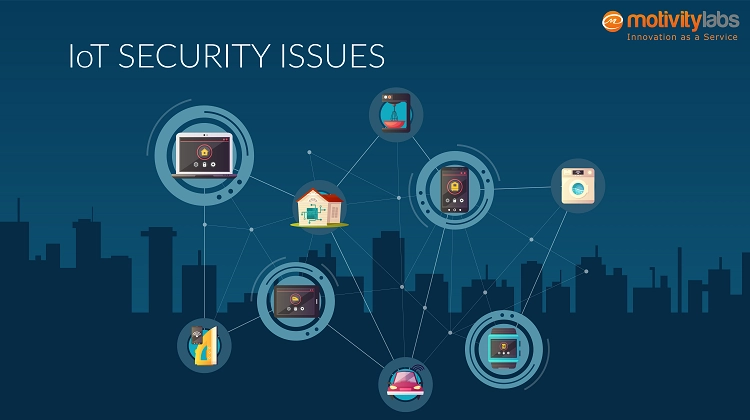Your IoT devices have become smarter by the day, but are you smart enough to use them? IoT security issues are the reason for this pertinent question. The future of IoT has immense potential and with accelerated advances in the industrial internet, together with evolving technologies like AI and 5G, IoT privacy and security challenges and solutions are on the verge of emerging as a great power. But, “with great power comes great responsibility”. Are the manufacturers responsible for dealing with IoT security challenges? Are the consumers aware of the IoT security risks? Let’s discuss the most important problems with IoT devices and the possible solutions in detail.
1. Access Control

Most IoT devices come with a single-level authentication and past that, there are no specific authorization levels, and due to this, anyone who breaches this single-level access control can gain access to the functionality of the device. These are the most important IoT security issues of almost all IoT devices. Things get worse when one or more devices are connected to the same local network and as these devices trust each other, all the devices in the network may be compromised.
Also, all the devices of the same model coming from a specific manufacturer have the same default username and password which are seldom changed by the end-users. This allows a hacker to get into a particular IoT device by trying default credentials.
The solution to the IoT security problems above is to have a basic awareness of the user side of how your IoT device functions. It is very important to change the passwords regularly in general and the default credentials in particular.
On the manufacturers’ side, they can build IOT devices with multiple authorization levels restricting the functionality of the device based on the level of authorization. They can also design their devices with different credentials for each of them rather than using the same credentials for all the units.
2. Encryption
All the IoT devices collect some sort of personal data and the same is transferred to a cloud, in most cases, as plain text without any encryption. When the data is transferred via the internet without encryption, the same can be obtained by a third party i.e., Man-in-the-middle, MitM anywhere in the network path right from the device to the endpoint. This obtained data can be used for various malicious purposes by hackers by modifying the same to suit their needs.

Especially in the medical field, lives may be at risk due to this. Pacemakers, defibrillators, and implantable cardiac devices are used to monitor and control patients’ heart conditions. These cardiac devices, when compromised in the case of St. Jude Medical’s implantable cardiac devices in 2016-17, may put all the patients using such medical IoT devices at risk. Any action taken on a false signal sent through a compromised medical IoT device can put a patient’s life in danger.
The solution to this IoT security risk can be fixed by encrypting the data not only while transferring it but also while it is at rest on the device. Strongly encrypted data and a reliable firewall may prevent hackers from obtaining the data. Also, when such IoT security problems are noticed by the device manufacturers, immediate action in the form of a firmware upgrade is necessary.
3. Physical Security

IoT devices like security cameras and motion detectors can be prone to physical abuse by hackers, especially when these are situated in remote locations for longer periods. When hackers gain access to an IoT device physically, they can tamper with the device to read the contents stored inside, which can be valuable data. In most cases, the user of the device may not know that his / her device has been hacked until it is too late. These IoT security issues are often overlooked because it is believed that all cyber-attacks are done through the internet.
IoT devices like security cameras and motion detectors can be prone to physical abuse by hackers, especially when these are situated in remote locations for longer periods. When hackers gain access to an IoT device physically, they can tamper with the device to read the contents stored inside, which can be valuable data. In most cases, the user of the device may not know that his / her device has been hacked until it is too late. These IoT privacy and security challenges and solutions are often overlooked because it is believed that all cyber-attacks are done through the internet.
4. Updates
Updates are the most important factor in maintaining the security of an IoT device. But unfortunately, most of the IoT devices out there do not have a proper update mechanism that allows malware like Darlloz which targets the IoT devices like routers, security cameras, and set-top boxes by exploiting a PHP vulnerability. Malware such as these uses information disclosure vulnerabilities which are usually old vulnerabilities that are later rectified. Any device which isn’t updated is prone to these attacks.

Even though manufacturers ship their IoT devices without any known vulnerabilities, there is no guarantee new loopholes wouldn’t arise at a later date. Hence, makers should have a proper, secure update mechanism wherein all the devices are updated safely once a vulnerability is discovered.
5. Invasion of Privacy

One of the most important IoT security risks is privacy protection. Almost all IoT devices record various personal information, right from video and audio recordings from surveillance cameras to data from smartwatches, health equipment, wearable bands, interactive dolls, etc. Once this personal data falls into the hands of a hacker, it can be used against its use or to extract a ransom. If this data belongs to a big industry, more damage is done to both the said industry and its customers as the data about both parties is now available to hackers.
One of the most important IoT security risks is privacy protection. Almost all IoT devices record various personal information, right from video and audio recordings from surveillance cameras to data from smartwatches, health equipment, wearable bands, interactive dolls, etc. Once this personal data falls into the hands of a hacker, it can be used against its use or to extract a ransom. If this data belongs to a big industry, more damage is done to both the said industry and its customers as the data about both parties is now available to hackers.
6. DDoS Attacks
This is another crucial issue of the major IoT security Issues that can impact a person or an industry with significant loss. A Distributed Denial of Service (DDoS) is a cyber-attack wherein many devices attack a single server. These infected devices overload the server with fake requests rendering it useless and crashing. These infected devices can be any device ranging from computers, and smartphones to personal gadgets. The one thing that connects all these devices is the Internet.

Hence, all IoT devices are prone to DDoS attacks. Usually, once the hackers attack a server or a person with DDoS, they demand a ransom to free the server or device. IoT devices with poor security are prone to DDoS attacks. The consequence of these attacks ranges from freezing an industrial server to locking your own house or your smart car from getting started unless a ransom is paid.
When a hacker can install his malicious software to run on IoT devices, they can become zombies and help achieve DDoS much faster. Restricting the functionality of the device and the software it can run can limit the possibility of a DDoS attack. This can be achieved by incorporating a cryptographic hash on all the valid software the device can run. This restricts the device to run only the software distributed by the manufacturer. Another way to restrict unauthorized software from being run is to implement code signing during the booting of the device.
7. Ignorant Users

Most IoT device users are not technical persons and often aren’t aware of the IoT security challenges their IoT devices to pose. Most users do not know when their device is compromised as the device appears to be performing normally. This prevents them from taking the necessary steps to resolve any unwarranted issue until the damage has been done by it.
These IoT security problems arise as most of the IoT devices out there do not have a mechanism to report the altering functionality or the system logs.
Vendors should incorporate certain functionalities into their devices that alert the users about any outside intrusion and system changes.
The above are a few of the IoT security issues that are currently prevailing. While the Governments and regulatory authorities should come up with stringent laws to protect the consumers, it is also on the part of manufacturers to gain the trust of their users by keeping them updated with regular security updates, a transparent approach, and prompt customer care especially in educating the users about the upkeep of their device.
The end-users, on the other hand, should be thoroughly aware of all the nitty-gritty of the IoT devices they are using. They should learn to read the instructions and follow basic precautions like updating their devices regularly, using strong passwords, and changing them regularly. They should also keep customer care info at hand in case of any emergencies.



